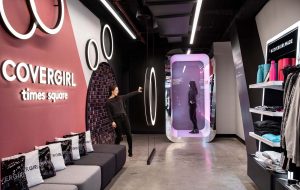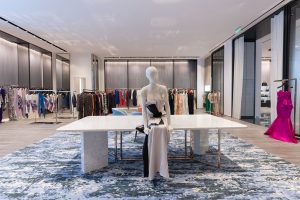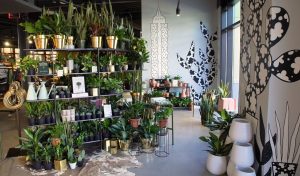Holistic Health in the Workplace
For many years, a WELL-certified office was the leading solution, but post-pandemic, it will become less of an added perk and more of a non-negotiable asset. Workplaces of the future will need to go beyond WELL and truly invest in their employees’ holistic wellbeing.
Multi-Story Future: What We Know, Where We Are Going
Future Proofing the Office
As designers driven by the prospect of transforming all dimensions of the human experience, we advocate for spaces that support health and wellness and create future proof concepts so that companies may adapt and evolve without the need for relocation. With every project, our team promises and delivers spaces that meet the standards of today and tomorrow.
Future of Finance: Experience Reimagined
The COVID-19 pandemic has reframed how many consumers assess their financial standing. With an increase in job fluctuation, economic instability, and personal stressors impacting our everyday lives, it’s no surprise that our attitudes toward spending, saving, and considering our personal finances has rapidly evolved over the last year.
NELSON spotlights five changing consumer behaviors that are impacting the financial services sector and how you can better position your brand for the future.
Environmental Graphic Design After COVID-19: Leveraging EGD to create engaging experiences
As the world continues to adapt and change, we seek to understand what some of the more unseen impacts may be. Graphic design is incorporated into every aspect of our lives in ways we aren’t always consciously aware of. It will influence our environments post-pandemic by focusing on ways to communicate new rules and processes, providing clarity on expectations, establishing a sense of community, and creating continuity for the future.
Retail After Covid-19: A New Connected Economy
Robyn Novak of NELSON Worldwide shares insight on the new, Connected Economy. One that places more value in meaningful experiences with a focus on authentic human connection, supported by revolutionary new technology that allows consumers greater access than ever before.
NELSON Worldwide to Acquire AOR Justice Business from CGL Companies
Award-winning architecture, design, and strategy firm NELSON Worldwide will acquire the architect of record (AOR) business from CGL Companies (CGL), a leading justice consulting and maintenance firm headquartered in Miami, FL.
On or before December 31, 2023, CGL will convey current architectural projects and associated architectural staff to NELSON. The move aligns with NELSON’s strategic plans to significantly grow its existing Civic & Justice practice.
“NELSON prides itself on its diversity of work and extensive reach. We recognize the growing importance of criminal justice and mental health reform in today’s industry. And while we are deeply involved in this sector, we view the CGL team as a pivotal addition to further expand this area of our practice. We look forward to collaborating with their vast expertise and talent,” said John “Ozzie” Nelson, Chairman and CEO, NELSON Worldwide.
NELSON’s Civic & Justice practice focuses on social impact that empowers local communities through innovative and functional design, creating environments and experiences that foster development and growth through comprehensive planning that exceeds the aesthetic, functional, and financial objectives of our clients. CGL brings more than 40 years of experience focused on Justice work, having designed more than 250 facilities around the world.
Founded in 1977, NELSON has been one of the industry’s most aggressive integrators in the AEC industry, offering a breadth of services across the globe that transform and touch all dimensions of the human experience, including architecture, interior design, graphic design, and brand strategy. The firm creates and delivers brand experiences, compelling environments, and smart solutions across the spaces we interact with daily—where we work, shop, dine, stay, serve, live, play, and thrive.
Both firms are committed to managing a seamless transition for employees and clients, who will continue to receive the same level of service and attention to detail they have come to expect from both organizations.
About NELSON Worldwide
NELSON Worldwide is an award-winning firm, boldly transforming all dimensions of the human experience through architecture, interior design, graphic design, and brand strategy. With more than 700 teammates across 20 offices, the firm’s collective network provides strategic and creative solutions that positively impact where people work, serve, play, and thrive. The team combines industry knowledge, service expertise, and geographic reach to deliver projects across the country and around the world. Visit www.nelsonworldwide.com to learn more.
About CGL Companies
CGL is a leading justice firm dedicated to providing criminal justice consulting and maintenance worldwide. With a team of highly skilled professionals, the company provides comprehensive consulting and advisory solutions to justice clients across the globe. CGL is committed to delivering excellence and making a positive impact in the field of justice.
Hotel Management: Wellness Healthy Habitats
“The building’s interior materials have low volatile organic compounds content. This along with the use of light-colored and warm natural materials within the Element brand also promotes a feelings of healthiness.”
Teammate Cheryl Smith describes some of the wellness elements incorporated into our project with the W Element Hotel. Read more with Hotel Management here.
175 Federal
Handing Over the Reins: Creating Experiential Retail Environments That Put Shoppers In Control
While COVID-19 had an immediate impact on the retail industry, brands quickly got creative, offering click-and-collect, curbside pickup, and speedy shipping options, giving consumers more control than ever before. And while these seamless amenities will continue to be anticipated, brick-and-mortar will still have a critical role in the future of retail.
So how do brands evolve their physical footprints into vibrant destinations consumers still want to visit? The best brands know how to captivate their audience at each visit, making a lasting impression and pairing it with a seamless experience. The reality is, these environments will have to remain experiential and engaging to make an impact.
Retailers can prevail over the hardships that come with COVID-19 by preparing for the future consumer, celebrating self-service, learning from luxury brands, and paying close attention to the smaller, local stores in their real estate portfolios.
Celebrate Self-Service
Advancements in technology have put consumers in the driver’s seat, accessing an unlimited amount of data from the palm of their hand. From convenience stores and grocery shops to car dealerships and beauty brands, retailers have experimented with contactless, and even unmanned, shopping experiences, and consumers are catching on. Research from eMarketer says 61 percent of consumers globally are interested in using unmanned stores. This seamless engagement is not only being accepted, it’s being requested.
What began as leveraging the latest technologies for efficiency, is now becoming a sought-after service model due to the onset of COVID-19. Consumers are not only more cautious about the spread of germs, but also craving a quick and easy checkout process, limiting the amount of time they spend in a physical store. And due to the general chaos consumers are feeling in 2020, control will be strongly desired in the coming years.
While these new, contactless methods are necessary, the overall experience must remain engaging, by eliciting moments of surprise or delight. For example, some beauty brands have taken a more playful approach to try on makeup now that customers may be more sensitive to in-store trials. Korean beauty brand Innisfree is taking advantage of smart mirror technology with facial recognition that allows customers to see what colors and styles look best on them. They can also share or save the result, all while reinforcing safety and trust throughout the process.

Covergirl Times Square – NELSON Worldwide
Learn from Luxury
When observing what brands are thriving through the global pandemic, luxury brands are unexpectedly set up for success. The type of white-glove, concierge service offered at a high-end retail store is unmatched in the shopping industry, and consumers are starting to recognize the value of this type of personalized, one-on-one attention.
Non-luxury brands can emulate this type of service by elevating their in-store experience, creating loyalty programs and VIP experiences that go beyond discounts and early access, instead of making it part of the in-store shopper journey. Giving consumers the option to shop by appointment, or even arrange for personal shopping assistance can help them feel empowered, pampered, and valued, improving the overall shopping experience. And this attention to detail doesn’t end with fashion, jewelry, or handbag brands, it can expand to beauty, electronics, home décor, and more.
Portland-based fashion retailer Garnish offers this type of customer experience in their stores, including appointment-based shopping with a stylist. The appointment includes a complimentary coffee, and carefully curated wardrobe pieces that highlight each customer’s shape and style.

Avanti – NELSON Worldwide
Embellish Non-Flagship Stores
With e-commerce dominating the market, the role of the physical store is evolving. The buzz around mega-flagship stores in major cities with a full line of merchandise is no longer as significant to consumers. Convenient, localized shopping experiences are more important than ever before, and retailers must rethink their real estate strategy and portfolio to attract and retain loyal shoppers.
Some stores may not focus on selling product, but instead, adopt a showroom model or offer relevant programming or services. The key will be connecting with shoppers in a meaningful, authentic way. Smaller, more adaptive environments will be welcomed by consumers and keep them coming back for new rotational merchandise.
Macy’s latest specialty concept, Market by Macy’s embodies local and creates a unique platform for storytelling, through curated merchandise, unique programming, and differentiated design. This small-format concept leverages a more residential design and bold graphics to introduce unique, brand stories while complementing the local neighborhood of each location. Customers can shop a curated mix of traditional Macy’s brands, as well as a rotational collection of private labels, direct-to-consumer products, and local apparel and home goods.

Market by Macy’s – NELSON Worldwide
The future of retail experiences have one thing in common, and that’s putting consumers first. The most engaging experiences will tap into self-service, unmanned options, as well as personalized, detail-oriented resources, and finally, locally celebrated moments of engagement. Together, each of these pillars will shape the role of the physical store, and keep consumers coming back long after the pandemic.
More commentary from Heesun Kim, design director at NELSON Worldwide, on using design and technology to reimagine experiential retail is featured in Retail Touchpoints.